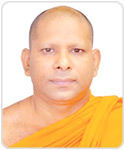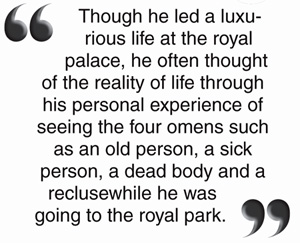
The Arising OF A Buddha Brings Happiness To All
 Senior Lecturer, Pandit, Senior Lecturer, Pandit,
Faculty of Humanities and Social Sciences
University of Sri Jayewardenepura
Dr. Ven. Dodamgoda SumanasaraThero
Over 2566 years ago, Prince Siddhartha was born on the Vesak Full Moon Day in
the month of May at the Lumbini Park in Kapilavatthu, North India. His parents
were King Suddhodana and Queen Mahamaya. At that time, King Suddhodana ruled the
kingdom of the Sakayas.
Unexpectedly prince Siddhartha’s mother, Mahamaya passed away seven days after
his birth. After that, Maha Prajapati Gotami brought up the child (prince
Siddhartha) as entrusting her own son.
 Prince Siddhartha was educated and was trained by a well-known and well-educated
teacher, Sarwamitra. Prince Siddhartha was educated and was trained by a well-known and well-educated
teacher, Sarwamitra.
According to the custom of that time, at the age of 16, prince Siddhartha
married the beautiful daughter of king Supprabuddha, princess Yashodhara. After
several years princess Yashodhara gave birth to prince Rahula.
As a young prince, Siddhartha had all the riches, comforts, and luxurious
facilities at his palace suitable for Summer, Winter, and Spring, and also he
was well secured by the guards of the palace.
Though he led a luxurious life at the royal palace, he often thought of the
reality of life through his personal experience of seeing the four omens such as
an old person, a sick person, a dead body and a reclusewhile he was going to the
royal park.
 Likewise, by understanding the reality of life, prince Siddhartha was not
content with anything else as he wanted to see the real world outside his royal
palace. Likewise, by understanding the reality of life, prince Siddhartha was not
content with anything else as he wanted to see the real world outside his royal
palace.
Thereafter, the young prince discarded enjoying sensual life and left his loving
son, Rahula, beloved wife, Yashodhara, and other material comforts in search of
the real happiness of life.
On the contrary, he intelligently came to know about people’s suffering in the
world and he was determined to find the solution to this universal suffering of
mankind. With a firm determination, at the age of twenty-nine, Prince Siddhartha
made his great renunciation (mahabhinikkhamana) in search of the perfect
solution to this suffering.
Thereafter, prince Siddhartha became an ascetic himself on the bank of the river
Anoma in the presence of his charioteer, Channa.
In quest of truth Bodhisatta Siddhartha walked alone and attended on the several
teachers namely Bhaggava, Alara Kalama and Uddakaramaputta to find the solution
to the universal suffering of mankind.
Though he gained the highest mental progress and mental concentration from his
teachers by practising their traditional methods of teaching, later he abandoned
them all.
Finally, the Bodhisatta was determined to seek the solution within himself by
practising his own ways and methods.
For six years, he experienced the rigorous ascetic practices by following both
extremes (ubho anta) of self-indulgence (kamasukhallikanuyogaya) and
self-mortification (attakilamathanuyogaya) but he was unable to find the
solution through those methods.
After that, by understanding this, the Bodhisatta engaged in the Middle Path
(majjhimapatipada) and practised the mind gradually towards the Noble Eight-Fold
Path (ariyoatthangikomaggo).
It consists of the three steps: wisdom (panna), morality (sila) and
concentration (samadhi). In the end, this method led him to achieve
Enlightenment by completely eradicating all defilements and impurities of mental
suffering such as desire, hatred, delusion, ignorance, conceit etc.
on the dawn of the Vesak Full Moon Day under the Bo Tree at Buddha Gaya. Since
then, he was known as the ‘Buddha’-The Fully Enlightened One.
After two months of his Enlightenment, the Buddha delivered his first Dhamma
discourse which he found and enlightened the five ascetics who lived in the Deer
Park at Isipatana in Banaras.
From that day, for 45 years the Buddha exposed his teaching for human beings;
Bhikku, Bhikkuni, Upasaka, Upasika, and divine beings; devas and brahmas, and so
on for their betterment in this life and the life after.
Without any discrimination against any person or group out of compassion, the
Buddha delivered his sermons equally for every person such as men, women, kings,
peasants, brahmins, outcasts, bankers, beggars, holy men, robbers, rich and poor
people, etc. to practise their minds towards the bliss of Nibbana.
As well as the Buddha who showed the way he practised for all human beings who
were ready to follow and understand his noble teachings. The Buddha himself
decided to keep his teachings open for all to practise in day-to-day life.
Until the last moment, the Buddha wandered from village to village with great
compassion to deliver his noble doctrine to the public for forty-five years with
his disciples. In the end, he reminded and encouraged all his Dhamma followers
to strive “appamadenasampadetha” (strive on with diligence) to attain
emancipation (vimuktti) in this birth.
As we all know as the disciples of the Buddha, the arising of a Buddha to the
world and having the opportunity to listen to the teaching of the sublime Truth
bring happiness to everyone because the Buddha and his teachings lead us to
purify our minds from vivid worries, suffering, defilements and so on. The
Buddha said happiness does not mean sensual pleasure, having delicious food, or
having riches or glory because all these pleasures cause more suffering in this
existence and the life after.
Ending the Buddha’s great and the noble service throughout the forty-five years,
remembering his last words “vayadhammasankhara, appamadenasampadetha” (transient
are all conditioned things.
Strive on with diligence) to all his disciples at the age of eighty, our great
teacher, the Buddha passed away (mahaparinibbana) in the Sala Grove of the
Mallas between the twin Sala trees in Kusinara on the Vesak Full Moon Day.
|
